Kerminy, a Space for Agriculture in Arts: Weathered Esthetics
Published 6 August 2024 by Marina Pirot et Dominique Leroy
This spring, Makery co-produced issue 6 of the occasional newspaper The Laboratory Planet. This issue imagines a peasant and neo-peasant future, invented by global peasants, organised in diverse territories, cultivating biotopes that are more heterogeneous, more democratic and therefore more habitable. The central section is devoted to the recent Soil Assembly initiative, and develops some of the experiences, reflections and surveys gathered within this emerging network. Here Marina Pirot and Dominique Leroy present Kerminy, an agricultural arts centre in Rosporden, Brittany, France.
Our artistic duo (n) (1) – Marina Pirot and Dominique Leroy – launched a “space for agriculture in arts” in 2020, in Kerminy, Cornouaille, Brittany, France. After experimenting artistically with sound and the soma (2) for two years (2018-2020) from our nomadic studio set up on an organic farming site on the outskirts of Nantes, our foray into fertile soil prompted us to found an experimental vegetable art farm, in order to pursue our esthetic investigations. Kerminy is an ancient 14th-century seigneury with a chapel, washhouse, outbuildings and woods, established on a 12.5-hectare estate that borders a large forest. The land adjoining the château is therefore free to use, and even to farm. So we wasted no time in anchoring our Cyclo-farm (3), a mobile agro-pasture vegetable and fruit micro-farm, created to run a self-sufficient food system by combining soft farming and art techniques.
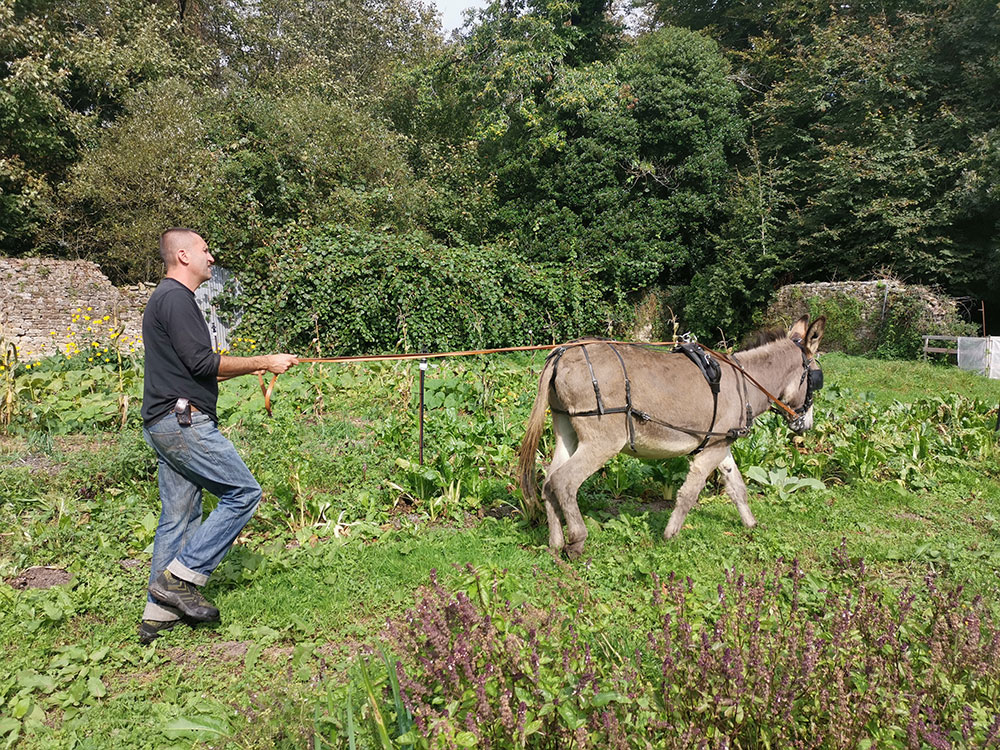
In Kerminy, we become artist-peasants, cultivators of resilience and regenerative autonomy, on the path to techno-economic deslavement, decolonizing narratives, and empowering both artistic and agricultural means of production. Like art research, agriculture in arts defines its method by practicing eco-creation (4) and processes of situated agency. Kerminy is an agrarian experiential terrain, backed by a self-managed artists’ residency (another (n) project: Open (5)), where we as sonomatic artists (6) and (n)’s regular artistic encounters (7) unfold.
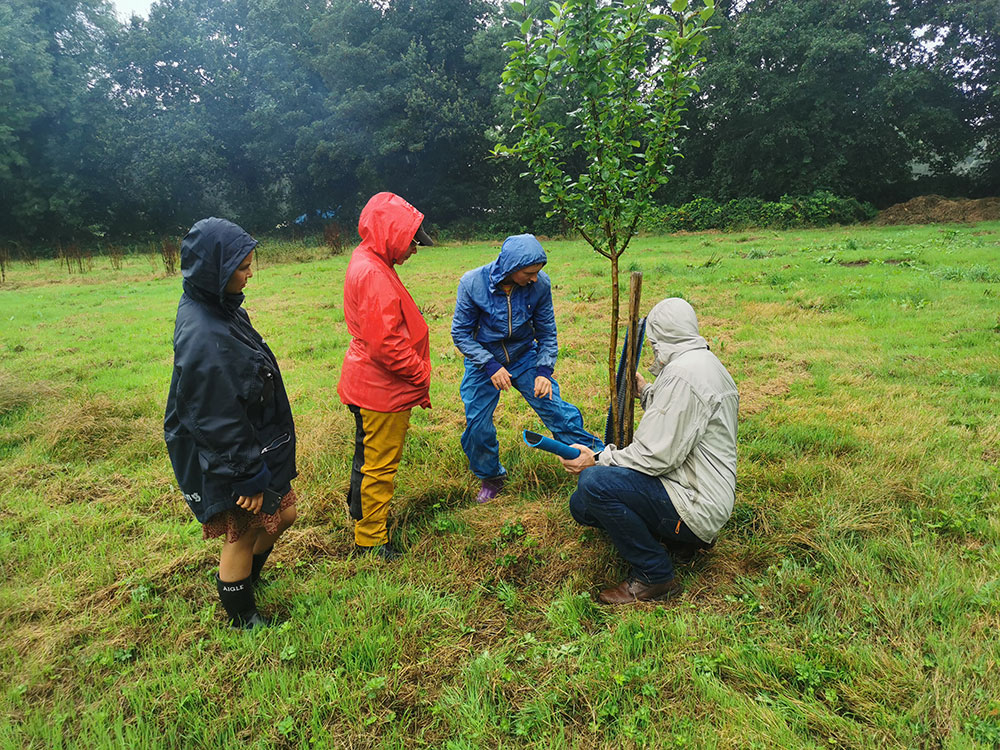
(n)’s sound and somatic art become sonomatic
In one of the active greenhouses, a permanently installed listening device sonifies (8) weather data from the surrounding landscape using live transduction (9). The greenhouse-laboratory-stage (“slabs”) becomes a stage for listening and creates a work atmosphere for the practice of vegetable gardening. Vegetables, as well as artists and interns, work in the slabs to the sounds generated by the day’s weather variables. The sound installation becomes an agricultural tool-instrument. Indeed, by growing vegetables in the greenhouse, we develop an acute sense of listening that allows us to perceive variations from one day to the next. We can “listen” to a high level of humidity, or an extreme temperature, and deduce that we need to open the greenhouse, for example. The artwork-instrument gives us precise information and bathes us in an environment that we share with plants. Strangely enough, as we receive the same frequencies with our very different systems of perception, we feel a certain continuity with vegetable otherness!
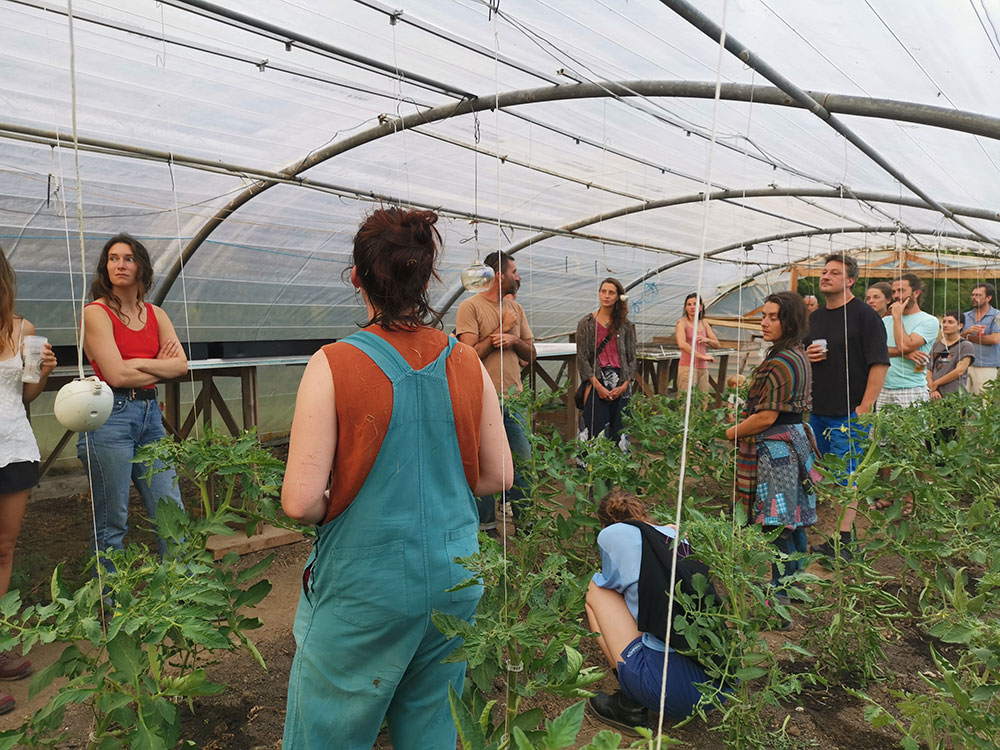
The somatic arts (10) often practiced in the slabs of Kerminy engage the perceptive faculties of our bodies at work in the nourishing landscape. Our body-weather (11), like an antenna that both transmits and receives, develops the potential for interspecific relationships with plants and animals, partners in daily practices through focusing our attention on breathing, skin, body systems and fluids, which reveal both kinships and asymmetries. Each season, we offer groups of participants guided somatic gardening sessions for sowing, transplanting, weeding or picking (12), in the form of workshops or contributory performances. The gestures and postures of gardening become movements of joint attention between participants and with the vegetables, sometimes leading to collective choreographies, as during the Cap Danse festival in 2023. And we often leave with a basket of vegetables! A “Potato Show”, a harvest of potatoes in a social agriculture-sculpture (13), is in the works for next September, to the rhythm of the sounds of the moment.
Our everyday art becomes sonomatic, as our internal and external listening practices cultivate passageways for interspecific exchange through these artistic devices within agricultural spaces.
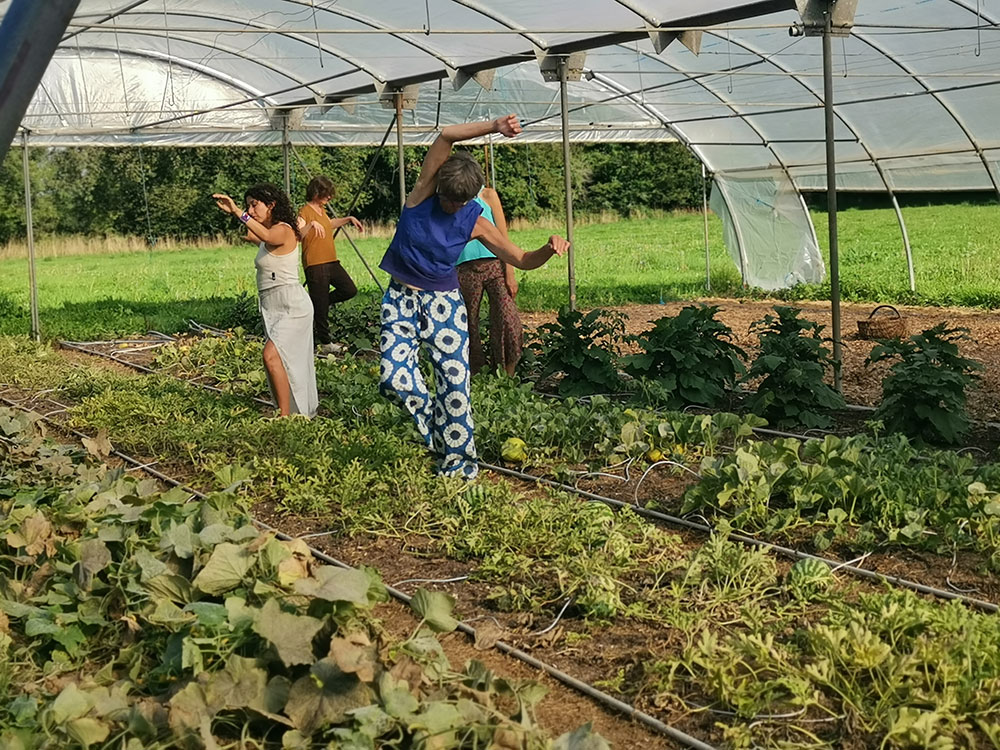
Tool-instruments for art
Farming tools are a research by (n) called Cyclo-tools (14). Our artistic approaches, modes of investigation and care for gleaned old tools, are conceived as an extension of the farmer-body, awakening gestural or technical memories. Tools that have emerged from pre-oil farming times are reshaped or augmented (with parts that are made in a workshop or 3D-printed, recycled PVC tubing, etc.), or simply reactivated by current gestures and materials, in a sort of solarpunk esthetic. The method involves hacking, or reappropriating manual techniques and know-how liberated from fossil fuels for a decarbonized technical future. For example, a hydraulic ram pump (made from PVC pipes and a fire extinguisher), pumps water up from the “fountain woods” to the greenhouses, using the energy of falling spring water. We used old streetlight bulbs to make a centrifuge for our experiments in clay-coating pre-sprouted seeds to sow directly on soil mulched with compost to avoid mechanical tillage.
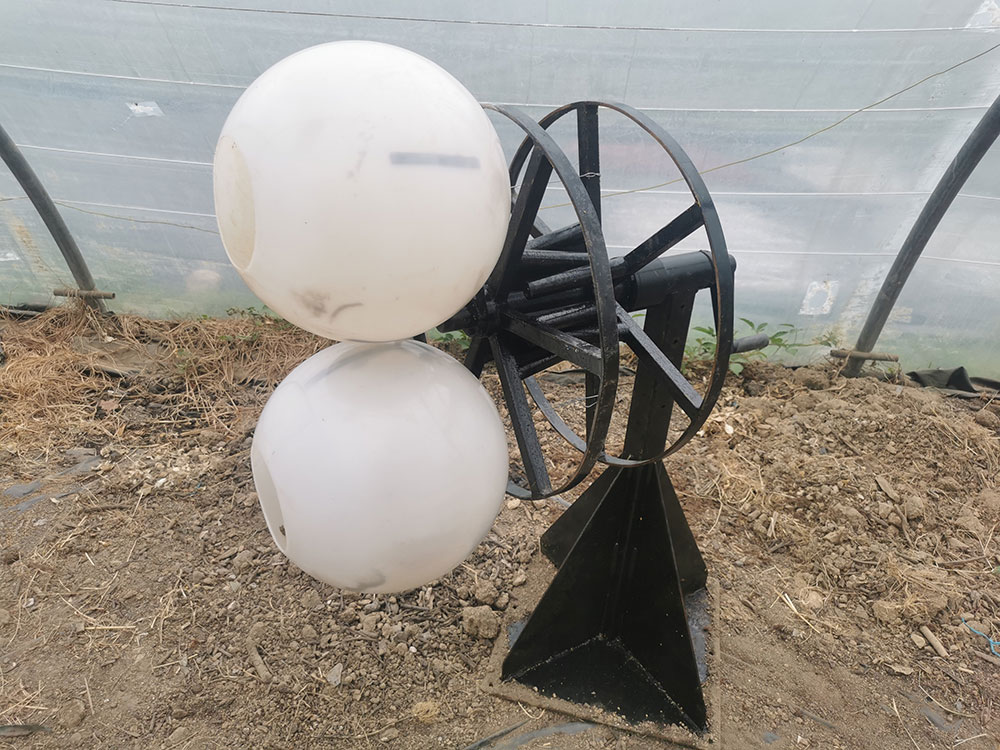
Two donkeys, Cyclo-farm’s new partners, accompany the preparation of humus and the fertilization of crop beds, pulling sledges of forest leaves to the crop beds. By reinvesting tools and fine techniques, right down to collaborating with animals, we relive the experience of a pre-motomechanized period, which hints at new possible technological paths, in line with current ecological creative actions (15). A new esthetic relationship born from technical reappropriation seems to engage us in new plant and animal relationships, in conditions that we are discovering are essential for nourished and nourishing soils.
Our duo (n) draws on Kerminy’s past temporal layers, while taking inspiration from futuristic solarpunk perspectives to activate creativities that combine art and agricultural scenes.
Kerminy’s concrete utopia also articulates “commons-singularities” (16), precisely because the site has become a breeding ground for plural emancipations, a test-space for long-term collective autonomies. It seems possible to reawaken the metamorphic power of an art that becomes less feral (17) than re-rooted, an art that rediscovers a soil. An art that promises us cultivated relationships, regenerating both our bodies and the living soil.
notes:
(1) n as nomadic in parenthesis in the sense of “nomadic thinking” (Deleuze) was born in 2015. The (n)omenclature is on n.kerminy.org
(2) Somatics are practices of bodily perception that refine our relationships with our environments. Among the most well-known are the Alexander technique, the Feldenkrais method, and Body-Mind Centering.
(3) Cyclo-farm is (n)’s agricultural project: cyclo-farm.kerminy.org
(4) (n) has been developing eco-creative projects since its previous lives, including Ecos, an urban arts and ecology organization co-founded by Dominique Leroy in 2006. Eco-creation is defined by Sophie Gosselin in Revue & corrigée #75, 2008, p.35.
(5) The Ope(n) project (open.kerminy.org) was inspired by the Performing Arts Forum in Saint-Erme-Outre-et-Ramecourt (pa-f.net).
(6) At the intersection of sound art practiced by Dominique (dominiqueleroy.info) and somatic art déveloped by Marina (marinapirot.info), our practices become sonomatic.
(7) Such as the Polusol or Agrilab art events hosted by Couëts, followed by Pandorhack, Fluxon and Ecosoma in Kerminy (park.kerminy.org).
(8) Sonification refers to the representation and transmission of physical data in the form of acoustic signals. In the greenhouse, weather data such as humidity, temperature, UV index are captured and sonified in real time.
(9) Transduction refers to the conversion of electrical energy into sound vibration. The tubes or polythene membrane of the greenhouse, when vibrated, act as an amplifier.
(10) “Matières-art somatiques” is the program developed by Anne Expert, based on the principles of Body-Mind Centering®, which Marina has been following since 2020.
(11) To reference a notion of the Body Weather Laboratory, which Marina explored during a collective research (2018-2020).
(12) Sessions performed as “body scores” of somatic gardening.
(13) In the 1970s, the artist Joseph Beuys (1921-1986) developed the concept of “soziale plastik”, social sculpture, by which society as a whole must be considered as a total artwork (Gesamtkunstwerk) to which anyone could creatively contribute. This idea is summarized by the phrase borrowed from Novalis: “Every person [is] an artist.” We speak of social agriculture-sculpture to extend Beuys’s concept to our context.
(14) The tool-making workshop Cyclo-tools is inspired by the American slow tools (slowtools.org).
(15) We refer readers to François Jarrige’s La ronde des bêtes, le moteur animal et la fabrique de la modernité, La découverte, 2023.
(16) Antoine Freychet, Démarches artistiques et préoccupations écologiques, l’écoute dans l’écologie sonore, l’Harmattan, 2022, p.283.
(17) Feral in the sense of Charlotte Cosson: an art that “would return to wild life, (…) from ploughing to the teeming of life, from conventional agriculture to agro-forestry, from industry to artistic freedom” in Férale, Réensauvager l’art pour mieux cultiver la terre, Actes sud, 2023, p.67.
The Laboratory Planet N°6 and the Soil Assembly booklet are made possible by co-funding from the Creative Europe More-Than-Planet and Rewilding Cultures programmes.
